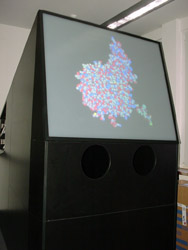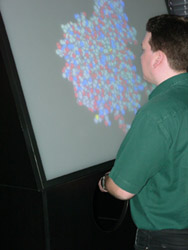
|
|
ERCIM News No.46, July 2001 [contents]
|
by Detlef Krömker and Christian Seiler
The Virtual Glove Box is a project which started in 2000 and is currently under development at the Fraunhofer Applications Centre for Computer Graphics in Chemistry and Pharmaceuticals in Frankfurt a.M., Germany. The core of the project is a new Virtual Reality I/O device in which virtual objects are shown in a stereoscopic display and can be manipulated with both hands by the user through haptic feedback devices.
The employment of simulation technology together with the exploration of 3D virtual environments creates a unique advantage in diverse fields such as planning, rapid prototyping, marketing and presentations, or information dissemination and training. This is particularly true if the focus is on inherently three-dimensional structures and their spatial layout. Such structures range from the macroscopic (eg assembly of parts, architecture etc.) to the microscopic (nanomachines, molecules, etc). However the intuitive usage of 3D computer graphics is often hampered by the fact that 2D interaction metaphors are used for interacting with 3D content. This makes it non-intuitive to manipulate three-dimensional content and is a reason why most people find it difficult to navigate and to orient themselves in a virtual 3D world. With the motivation to leverage the use of 3D computer graphics and virtual reality for different purposes and different user groups, we introduce an innovative dedicated I/O device. This interaction device overcomes limitations of traditional interaction devices, even those that are dedicated to 3D (eg the space mouse, or the PHANToM).
In order to overcome the problems and obstacles described above, we introduce a new I/O device called the ‘Virtual Glove Box’. A glove box is an apparatus used in chemistry or biology to work on a targets in a closed atmosphere, without contaminating the substances or endangering the user. A glove box usually consists of a transparent hull in which the experiments can be performed. The user can reach into the box through gloves which are attached at the inside of the box. The gloves can be reached through corresponding holes in the box.
We used the glove box metaphor to build our Virtual Glove Box. The Virtual Glove Box combines a stereoscopic display with haptic displays. The stereoscopic part consists of a two projector system with polarised lenses which continuously display images for each eye. The user views the scene through matching polarised glasses. Directly below the display frame are two openings through which the user can reach into the box. The user cannot see his real hands but rather a computer generated representation which mirrors the user’s motions. We achieve haptic feedback by using a Cyber Grasp exoskeleton for each hand. In this way the user can actively reach into the virtual domain to grab and move the virtual objects there. One of the technical obstacles in this set-up is to avoid the user reaching into the projector beam. Another problem with an exoskeleton-only approach is that gravity cannot be displayed in this set-up. We are currently evaluating different approaches to solve this problem, for example, the inclusion of a robot arm.
The usage of a real life interaction metaphor like a glove box greatly increases the user’s acceptance for such a new device. The Virtual Glove Box enhances the immersion since the haptic exoskeletons worn by the user are hidden from view by the apparatus, and a holistic approach is thus presented for immersive VR devices with haptic feedback. The Virtual Glove Box offers a multitude of different fields of application wherever interaction with virtual objects is required. The foremost area of application as described above is the planning, modelling and simulation of structures on a microscopic level and smaller, like molecular structures of three-dimensional objects from production plants, machinery, pipeline systems etc. The usage is not limited to real objects, since abstract systems like work flow diagrams can be similarly experienced. A very important aspect of the device is the communication presentation and visualisation of new ideas or solutions, which opens the usage of the Virtual Glove Box to many different sets of users. Experts benefit from intuitive interaction because they can concentrate on their domain competences (eg design or mechanics) rather than having to learn to interact with complicated authoring systems. Users from management or marketing, and customers, share the same benefit: things can be easier to communicate and understand if you have a ‘hands-on’ experience.
 |
 |
| Figure 1: Virtual Glove Box prototype. | Figure 2: User in front of the Virtual Glove Box. |
We have described a new I/O device for intuitive human computer interaction. The device itself offers many advantages over conventional I/O devices as described above. Beside the implementation of the device there is another important aspect of the Virtual Glove Box project: the user interacts with virtual objects. Therefore the description of such an object must include not only visual properties, as in other VR applications, or the haptic description, but also a behavioural description. We are currently improving a component-based description model to incorporate the different aspects of a virtual object (visuals, haptics, simulation, etc.) into a software framework.
Please contact:
Detlef Krömker — Fraunhofer Applications Center for Computer Graphics in Chemistry and Pharmaceutics, Germany
Tel: +49 69 97 99 51 00
E-mail: krömker@agc.fhg.de